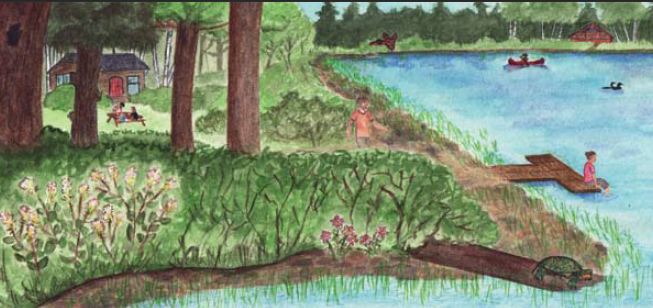Lake shorelines and riparian zones are important habitat for many species. Atlantic Coastal Plain Flora grow in these areas, Eastern Ribbonsnakes feed and bask there, and Blanding’s Turtles nest on their gravel slopes. People also love lake shorelines for activities such as swimming and fishing. Together, there are many ways that people and species at risk can share this habitat.
Preserve the natural vegetation along your lake shoreline.
The best and easiest thing you can do is let your lake shoreline be. The tidier your lake front area is,the dirtier your lake will be. This is because the riparian and shoreline vegetation acts as a natural filter and helps maintain high water quality by filtering out eroded soil, pollutants, and nutrients before they enter the water. This vegetation also slows runoff, which helps to prevent erosion, flooding, and sediment build-up. Modifying this area to suit your needs (for example, creating a small natural path) is well within reason but it would be best to try and keep this area as natural as possible. At least 30 m (100 feet) of natural vegetation from the lake shoreline is ideal (the more the better), but any amount is beneficial.
Allow your lake shoreline and riparian zone to grow back naturally and/or plant native vegetation if your shoreline has already been cleared.
To encourage the reappearance of native plants spread a layer of leaves over your lawn or cleared area to discourage grass growth and slowly observe the reappearance of other plants. To speed up the process you can plant native plant species that would be found in your riparian zone (ask your local garden center to supply native plant species). Areas with curvy instead of straight edges are more welcoming to wildlife.
Use public access boat launches instead of creating a boat launch on your property.
Boat launches require extensive shoreline modification and a road down to the lake. Public access boat launches are an easy way to get your boat in the water without impacting your shoreline. To increase the length of the natural lake shoreline try to group shoreline, developments in one small region instead of having them spread out.
Do not infill, rake, or mow your lake shoreline, or install concrete/rock walls.
The most effective and easy way to prevent lake shoreline erosion is to maintain the natural vegetation. Complicated measures such as retaining walls or rock walls are expensive and actually increase erosion over time. They not only reduce water quality by preventing water filtration and purification, but also impact water currents, and destroy fish and shoreline habitat. Raking or mowing the shoreline can disturb and destroy Atlantic Coastal Plain Flora species and wildlife habitat. All lake shoreline modifications below the ordinary high water mark require approval from Nova Scotia Environment and in some cases the Department of Fisheries and Oceans.
Artificial beaches are bad news for wildlife.
Any shoreline alteration requires approval from Nova Scotia Environment (refer to the 'Contact Information' page). Replacing natural lake shorelines with an artificial beach directly modifies the habitat required by wildlife. It is also costly and temporary because the sand often washes away. The displaced sand is destructive when it settles elsewhere; it can smother fish spawning areas, insect and amphibian habitat, and aquatic vegetation that would otherwise provide food and shelter for a variety of wildlife. Property owners with existing artificial beaches can stop adding sand and let the area to return to its natural state.
Pruning some of your trees instead of cutting them down is a great way to obtain a view of the lake while keeping the trees on your property.
Trees reduce runoff, stabilize the soil, provide habitat for wildlife, and keep the ground cooler and more drought resistant during the hot summer months. Trees near your house can help regulate the temperature and reduce heating and cooling costs by over 20%. Dead trees (standing or fallen) provide habitat and shelter for a variety of wildlife species. Trees can be unintentionally weakened by certain pruning techniques - see the next page for tips on how to avoid this.
Lake shorelines are no place for vehicles - drive on roads designed for vehicle traffic.
The Off-highway Vehicle Act does not permit off-highway or all-terrain vehicle use in sensitive habitats such as wetlands, rivers, lake shorelines, sand dunes, beaches, and barrens. Fines for driving in these habitats range from 500 to 2000 dollars. Driving along the shoreline directly damages plant species and compacts the soil, making it hard for plants to grow back. Compacted soil can destroy up to 90% of the underground seed bank and water quality is reduced with soil bank erosion. Call the Department of Natural Resources (1-800-565-2224) if you observe anyone driving vehicles in sensitive areas.
Reduce the number and width of access paths to the lake.
This will reduce soil compaction, erosion, and the chances of introducing invasive alien plant species. Paths made of porous materials like gravel and wood chips that wind and curve down to the lake (instead of heading straight towards the water) will reduce runoff into the lake.
Create wildlife corridors to allow access to the lake.
Many wildlife species require access to fresh water and will not move across open areas to get to the water’s edge. Areas with thicker vegetation such as shrubs down to the lake shoreline will encourage wildlife movement and allow for great wildlife viewing. Have a family day where you plant native trees and shrubs and have fun!
Resources:
The Shore Primer: A Cottager’s Guide to a Healthy Waterfront
Produced by Cottage Life and Fisheries and Oceans Canada. Provides great information about how to preserve your lake shoreline and ways to restore altered shorelines. Call 1-866-333-6676 for a free copy or view online by searching “Cottage Life, Shore Primer” in your internet browser.
The Living By Water Project
http://naturealberta.ca/programs/living-by-water
The publication “On the Living Edge: Your Handbook for Waterfront Living” is available to order (for $15) under resources.



